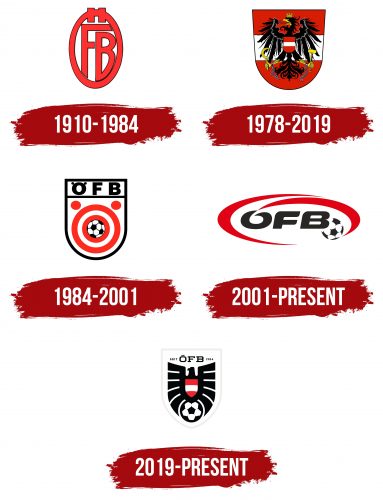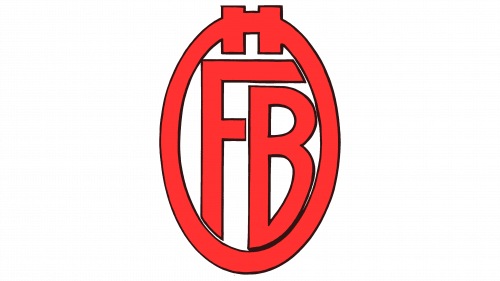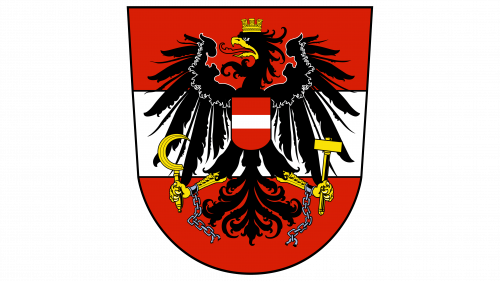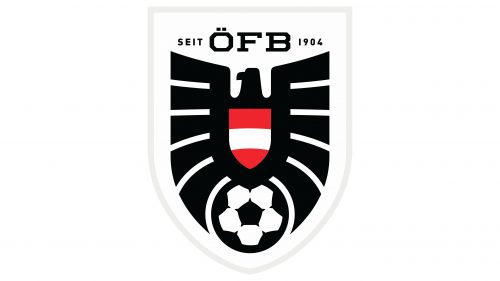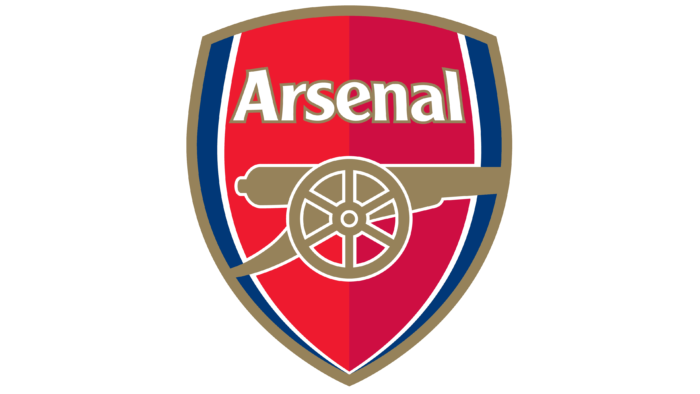 Austria National Football Team Logo PNG
Austria National Football Team Logo PNG
The Austria National Football Team’s logo resembles a swift, powerful bird. With wings spread, the eagle leads the ball toward the opponent’s goal. The team’s emblem symbolizes the athletes’ strength, agility, and masterful ball control qualities.
Austria National Football Team: Brand overview
The story of the Austrian national football team is one of overcoming challenges and achieving greatness through perseverance. Football found its roots in Austria, a nation nestled in the Alps, even though the team often remained in the shadows of its Central European neighbors.
The Austrian Football Association was established in 1904. The national team first assembled in 1905 and played its inaugural official match against Hungary in 1908, narrowly losing 5-4. Austria took its initial steps into international football in the early 20th century, competing in the World Cup qualifiers for the first time in 1931. Despite regular efforts, significant success remained elusive for many years.
The 1930s marked the golden era of Austrian football. At the 1934 World Cup, Austria achieved a remarkable fourth-place finish, bowing out to future champions Italy in the semifinals. The 1938 World Cup saw Austria securing silver medals after another face-off with Italy in the final. This illustrious team, known as the “Wunderteam” or “Wonder Team,” played a pioneering attacking style that etched its name into football history.
The 1950s and 1960s saw Austrian football buoyed by talents like Ernst Ocwirk, Ernst Happel, and Robert Dienst. These players helped establish Austria as a solid force in European football. A notable achievement from this era was reaching the quarterfinals of the 1954 World Cup, where “Das Team,” as the national team is affectionately known, was bested by eventual champions West Germany.
Post-World War II, Austria struggled to replicate its earlier successes on the international stage. The national team made it to the World Cup finals only twice more, in 1958 and 1978, but both times exited after the group stages. The subsequent two decades were marked by decline, as the teams of the 1970s and 1980s lacked the quality of their predecessors. Austria often failed to progress through qualification stages, offering occasional glimmers of hope with notable victories over powerhouses like the Netherlands and Italy.
The 1990s brought a resurgence. A new generation of players, including Toni Polster, Andreas Herzog, and Christian Prosenik, revitalized the team. For the first time in years, Austria became a serious contender in qualifying for major tournaments. The long-awaited breakthrough came in 2008 when Austria co-hosted the European Championship and reached the finals for the first time. However, the team struggled and finished last in their group.
The arrival of David Alaba in 2009 marked a turning point. The young Austrian quickly became a key player, paving the way for a wave of talented youngsters. Soon, Alaba was joined by players like Martin Harnik, Marko Arnautović, and Christian Fuchs. Dubbed the “Golden Generation,” under coach Marcel Koller, these players secured regular tournament qualifications and developed a national football philosophy centered on attacking play.
At Euro 2016 in France, the Austrian team captured the hearts of fans with their daring and attractive style of play. A memorable match against Portugal, who would go on to win the tournament, showcased Austria’s “Viennese” style—characterized by intricate passing, disciplined positional pressing, and efficient finishing. In 2019, Austria achieved its highest-ever FIFA ranking, climbing to 22nd place.
The 2020s saw Austria’s success becoming more consistent. At the 2022 World Cup in Qatar, “Das Team” advanced from their group, with Alaba receiving accolades for his outstanding contributions. As new talents like Christoph Baumgartner and Sasa Kalajdzic emerged, it became clear that the legacy of Austria’s “Golden Generation” would endure. Their blend of elegance and efficiency inspires and captivates football enthusiasts worldwide.
Meaning and History
What is the Austria National Football Team?
The Austria National Football Team represents Austria in international football competitions. Managed by the Austrian Football Association (ÖFB), the team has a long and storied history in European football. Known for its disciplined and tactical approach, the team has produced many talented players who have excelled domestically and internationally. Austria has participated in various major tournaments, earning respect for its competitive spirit and commitment to the sport. The team’s passionate supporters and strong footballing tradition make them notable in international football.
1910 – 1984
The first emblem of the team is associated with The Austrian Football Association (Österreichischer Fußball-Bund). An elegant monogram is formed from the first letters of the organization’s name – ÖFB. The red oval letter “O” encompasses the other symbols, representing unity and playing for the glory of Austria. The bright color demonstrates the athletes’ speed, skill, and ability to move quickly on the field and react instantly to the opponent’s challenges. The shade conveys energy and leadership. The rounded shapes echo the ball. The logo was created in 1910 for the national team’s first international match. This date marks the team’s founding.
1978 – 2019
The logo was changed to reflect new achievements and the updated image of the team following their impressive performance at the 1978 World Cup in Argentina, where they reached the second stage and defeated Germany.
The logo is filled with national pride and consists of symbols of the country: against the backdrop of the Austrian Archduchy’s coat of arms, which features a shield with two red stripes and one white stripe, there is a heraldic eagle.
The crowned bird has broken the chains of bondage and holds a sickle and hammer in its talons, symbolizing the unity of workers and peasants. Each element of the bird is intricately detailed, and the ancient coat of arms is repeated in the center to emphasize deep respect for their roots.
The emblem represents the team’s pride in representing their country and the joy of having the opportunity to bring honor to their homeland.
1984 – 2001
By Euro 1984, the team updated their logo once again. The emblem features a shield, symbolizing strong defense. At the top, the abbreviation of the country’s football association is displayed.
Below that, the first letter of the word “Österreich” is transformed into a dartboard target with concentric circles. This symbolism represents determination and teamwork towards victory.
At the very center, a football is depicted, highlighting the main element of the game. The design imitates a goal, reflecting the team’s aspirations.
The red, white, and black hues symbolize the country’s national colors. The emblem encodes victories in Austria’s name.
2001 – today
The logo was updated to revive interest in the team because the athletes did not qualify for all international tournaments, and the team needed renewal.
Two semi-ovals formed a single figure, symbolizing the trail of a flying ball. One element smoothly transitioned into the letter Ö. In the center, the abbreviation ÖFB was placed in a sleek black font.
The emblem looks very dynamic, representing the players’ speed and skill. Smooth lines emphasize coordinated teamwork. The division into two elements separates the team’s past and future.
2019 – today
The team reached the playoffs of the 2020 European Championship and underwent a rebranding to refresh its image before international competitions.
The new emblem is based on the modern coat of arms of Austria and the coat of arms of the Austrian Archduchy. A white shield, symbolizing fair play, is adorned with a black eagle. With wings spread, the bird grasps a soccer ball in its talons. The national flag is at the center, where a heart would be. The founding year of ÖFB is indicated at the top.
The logo exudes patriotism. Players see themselves as proud birds—strong, free, and brave. They skillfully control the ball and lead the game to victory.
The logo’s geometric precision and symmetry make it visually pleasing. The broad white lines at the edges symbolize a new beginning and the team’s renewal.
